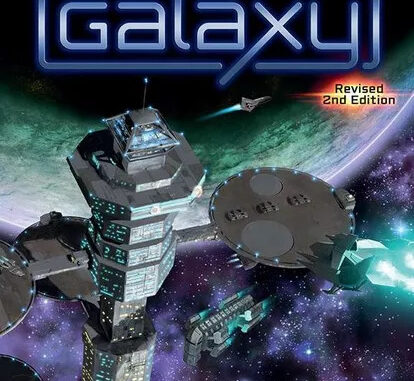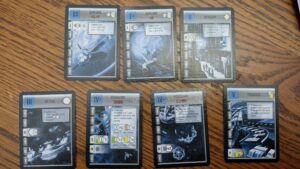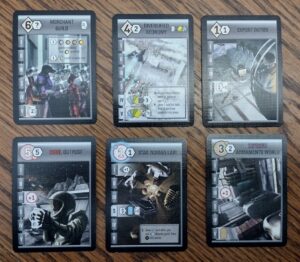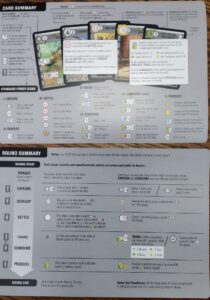
Do you want to conquer the galaxy but don’t really want to fight anyone? Race for the Galaxy may be for you.
Gameplay- A
This a tableau building game. Your goal is to score the most points by colonizing/conquering planets, ie playing them in front of you. The game ends on the round that someone builds their 12th planet or the last victory token is taken from the center of the table. Who ever has the most VP at the end of that round, wins.

Sounds simple enough, and it is, but the game appears more complicated. Before I played, I watched this video which broke the game down very well, as the instruction book appears daunting. We’ll only do a quick overview.
The game is played over a series of five phases. Not all phases occur each round. Instead, each player will reveal an action card which aligns with one of the phases. This is done simultaneously so you could have several different phases, or everyone could have played the same one. If a phase happens during a round, everyone gets to participate in it, even if they didn’t play the matching card. However, if you did play the action card matching the phase, you get a bonus. Additionally, if any cards in your tableau, i.e., those you have played on the table, have a symbol in the matching phase, then there is some effect that you, and only you, get.
The first phase, Exploration, is all about drawing cards. The basic action is to draw two cards and keep one of them. There are two matching action cards you could play. One allows you to draw five extra cards, allowing you to choose one card to keep from seven total. The other lets you draw an extra and keep an extra, so draw three, keep two.
The second phase, Develop, is all about building industry cards. These are the diamond cards. If you played the matching action card, it allows you to build them for one cost less. So how do you pay for a card? Each card will have two numbers in the upper left-hand corner. The bigger number is the card’s cost, the smaller is the card’s worth in victory points (VP) at the end of the game. To play a card with a cost of three, you need to discard three other cards from your hand.

Development cards generally are not worth many victory points on their own but provide you with bonuses. Many give you extra effects during different phases, such as drawing extra cards during Explore, or discounts when building/colonizing other cards. Additionally, there are some six cost Development cards (very expensive) that can be worth massive VP, if you meet certain criteria. These are the kind of cards you build your tableau around.
The third phase is Settle, where you colonize or conquer planets, i.e., your circle cards. It’s important to note the distinction here before colonize and conquer. Many worlds have a black circle and number. These are colonized and you purchase them the same way you do Development cards, by discarding the matching number of cards from your hand. However, some worlds have a red circle and number. These worlds must be conquered with your military. Each player starts the game with zero military. You can acquire more by playing cards with a red military symbol on them. These symbols are all added up to determine your military value. The great thing about this is that you can play conquerable cards from your hand that are at or below that number. You don’t have to spend any other cards to play them. This allows you to build up a decent military and then play any high value conquerable planets you happen to draw.
The fourth phase, has two sub-phases; Trade and Consume. You have two possible actions cards to play, one gives you bonus points during the Consume phase. Consume is the only one you can participate in unless you played the Trade action card. During Consume phase you turn resources on your planets, denoted by cards lying face down, into VP. You must do this for each card in your tableau that has a matching Consume power.
If you played the Trade action card, this phase happens before consume. If you have a planet with a trade power, it allows you to turn those same resources into new cards instead of VP. This is useful if you need cards in order to play a good card. Or if you’re not ready to end the game yet. The VP you gain from Consume come from the pool in the center of the table. When the last token is taken from the center the game will end at the end of the round, but that doesn’t mean you stop getting VP tokens. If there are three tokens left, and you earn five, you’ll still get five, they just come from the spares in the box. The ones in the center are only a timer.
The final phase is Produce. This is where you get resources with which you can trade and consume. During this phase, any world with a solid color circle, gains a card. Some planets, called windfall worlds, start with resources on them, but don’t gain a new one during this unless you played the matching action card.
Production- A-
In the box, you get a bunch of cards, some tokens and four cheatsheet boards. That’s all there is to the game. Which is a refreshing change from more complicated games with a million different parts. Aside from VP tokens, everything is just a card.

The cards themselves contain all the information you need to use them to play the game. This can feel a bit overwhelming, especially at first. A lot of the information is conveyed only through colors and shapes. Once you understand it, the cards work. A few of the more complicated ones do have text to clarify and remind you of what their symbology means, which is helpful. While it can feel like a lot, it is incredible how much information is conveyed with just these basic symbols.
The cheatsheet cards expand on the cards symbology to give you more details about what all the different icons means. This is very handy because digging through the rulebook every time would be annoying. The main downside to the cheatsheets is they are so big. Because there’s so much information they need to convey, they have to be quite large. And they are the only reason the box is as big as it is. The cards and tokens could fit in a much smaller box. But these sheets necessitate the box being as big as it is and having mostly empty space.
Theme- A
Surprisingly, considering all you are doing is playing cards onto the table, the game does convey its theme quite well. The artwork on the cards are that of planets or industries that match the name of the card. This helps to make them more than just symbols and numbers. That’s always the main trick.
In addition to the artwork itself, the different colors of the cards each have a theme among themselves. Yellow cards are alien artifacts. Brown cards are industrial. The artwork and names work together. Mechanically, they also mesh as many cards encourage you to play more of the same color. This leads to you playing similar cards when possible and developing a theme for your empire. Maybe you’re going military and play some Imperium cards and conquer rebel words. You’re essentially the Galactic Empire. It’s all generic art but it evokes Star Wars. Or you’re going brown and you have a bunch of robots and mining equipment because you’re a mining conglomerate.
Expansions- TBD
There are many different expansions. From what I’ve gathered, each expansion adds a new theme to the game and a bunch more cards. I could see this becoming unwieldy if you get a bunch and use them all at once. Your odds of drawing any one card get lower and lower. But, having played the base game several times, having more cards in the mix would be nice. We’ve already grown familiar enough with them to feel like we’re always using the same cards.
Conclusion- A
Despite looking a little overwhelming at first, this is a fun, quick game that is easy to play. There is strategy involved, especially when deciding what action card to play each round. If you need to draw a card in order to be able to afford to settle a planet, do you think your opponents are more likely to Settle or Explore? You want to do both. But aside from that, and another player playing a card you might want, that’s it for player interaction. What you do in your tableau doesn’t affect other players, making it a low stakes competitive game.
We’ve played it multiple times since learning to play so I can highly recommend it.

Wayne Basta
Latest posts by Wayne Basta (see all)
- X-Wing Tier List – Rebels - May 10, 2023

